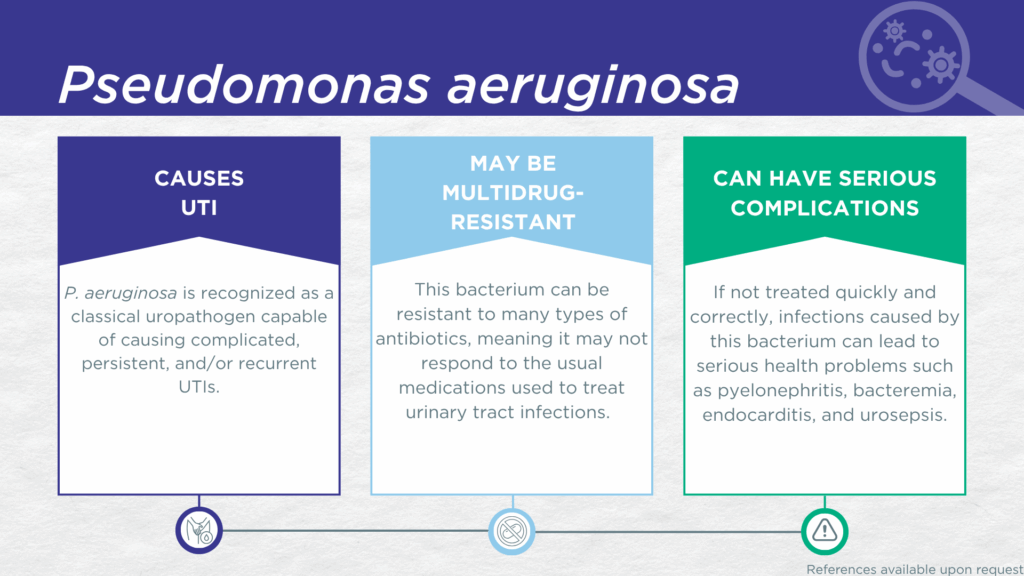P. aeruginosa

Emery Haley, PhD, Scientific Writing Specialist
CHECK BACK SOON FOR OUR FULL BLOG ON THE IMPORTANCE OF PSEUDOMONAS AERUGINOSA
Subscribe to our emails and get notified as soon as new blogs are published.
1. BacDive | The Bacterial Diversity Metadatabase Available online: https://bacdive.dsmz.de/ (accessed on 11 February 2025).
2. AL-Khikani, F.H.; Ayit, A.S. Pseudomonas Aeruginosa a Tenacious Uropathogen: Increasing Challenges and Few Solutions. Biomed. Biotechnol. Res. J. (BBRJ) 2022, 6, 311–318, doi:10.4103/bbrj.bbrj_256_21.
3. Miller, W.R.; Arias, C.A. ESKAPE Pathogens: Antimicrobial Resistance, Epidemiology, Clinical Impact and Therapeutics. Nat. Rev. Microbiol. 2024, 22, 598–616, doi:10.1038/s41579-024-01054-w.
4. Gaston, J.R.; Johnson, A.O.; Bair, K.L.; White, A.N.; Armbruster, C.E. Polymicrobial Interactions in the Urinary Tract: Is the Enemy of My Enemy My Friend? Infect Immun 2021, 89, doi:10.1128/iai.00652-20.
5. Mekonnen, S.A.; Husseini, N.E.; Turdiev, A.; Carter, J.A.; Belew, A.T.; El-Sayed, N.M.; Lee, V.T. Catheter-Associated Urinary Tract Infection by Pseudomonas Aeruginosa Progresses through Acute and Chronic Phases of Infection. Proc. Natl. Acad. Sci. 2022, 119, e2209383119, doi:10.1073/pnas.2209383119.
6. Penaranda, C.; Chumbler, N.M.; Hung, D.T. Dual Transcriptional Analysis Reveals Adaptation of Host and Pathogen to Intracellular Survival of Pseudomonas Aeruginosa Associated with Urinary Tract Infection. Plos Pathog 2021, 17, e1009534, doi:10.1371/journal.ppat.1009534.
7. Parente, G.; Gargano, T.; Pavia, S.; Cordola, C.; Vastano, M.; Baccelli, F.; Gallotta, G.; Bruni, L.; Corvaglia, A.; Lima, M. Pyelonephritis in Pediatric Uropathic Patients: Differences from Community-Acquired Ones and Therapeutic Protocol Considerations. A 10-Year Single-Center Retrospective Study. Children 2021, 8, 436, doi:10.3390/children8060436.
8. Wang, D.; Haley, E.; Luke, N.; Mathur, M.; Festa, R.; Zhao, X.; Anderson, L.A.; Allison, J.L.; Stebbins, K.L.; Diaz, M.J.; et al. Emerging and Fastidious Uropathogens Were Detected by M-PCR with Similar Prevalence and Cell Density in Catheter and Midstream Voided Urine Indicating the Importance of These Microbes in Causing UTIs. Infect. Drug Resist. 2023, Volume 16, 7775–7795, doi:10.2147/idr.s429990.
9. Haley, E.; Luke, N.; Mathur, M.; Festa, R.A.; Wang, J.; Jiang, Y.; Anderson, L.A.; Baunoch, D. The Prevalence and Association of Different Uropathogens Detected by M-PCR with Infection-Associated Urine Biomarkers in Urinary Tract Infections. Res. Rep. Urol. 2024, 16, 19–29, doi:10.2147/rru.s443361.
10. Akhlaghpour, M.; Haley, E.; Parnell, L.; Luke, N.; Mathur, M.; Festa, R.A.; Percaccio, M.; Magallon, J.; Remedios-Chan, M.; Rosas, A.; et al. Urine Biomarkers Individually and as a Consensus Model Show High Sensitivity and Specificity for Detecting UTIs. BMC Infect Dis 2024, 24, 153, doi:10.1186/s12879-024-09044-2.
11. Parnell, L.K.D.; Luke, N.; Mathur, M.; Festa, R.A.; Haley, E.; Wang, J.; Jiang, Y.; Anderson, L.; Baunoch, D. Elevated UTI Biomarkers in Symptomatic Patients with Urine Microbial Densities of 10,000 CFU/ML Indicate a Lower Threshold for Diagnosing UTIs. MDPI 2023, 13, 1–15, doi:10.3390/diagnostics13162688.
12. Wu, Y.; Li, P.; Huang, Z.; Liu, J.; Yang, B.; Zhou, W.; Duan, F.; Wang, G.; Li, J. Four-Year Variation in Pathogen Distribution and Antimicrobial Susceptibility of Urosepsis: A Single-Center Retrospective Analysis. Ther. Adv. Infect. Dis. 2024, 11, 20499361241248056, doi:10.1177/20499361241248058.
13. Babich, T.; Naucler, P.; Valik, J.K.; Giske, C.G.; Benito, N.; Cardona, R.; Rivera, A.; Pulcini, C.; Fattah, M.A.; Haquin, J.; et al. Risk Factors for Mortality among Patients with Pseudomonas Aeruginosa Bacteraemia: A Retrospective Multicentre Study. Int. J. Antimicrob. Agents 2020, 55, 105847, doi:10.1016/j.ijantimicag.2019.11.004.
14. Dimadi, I.I.Y.; Murillo, M.R.; Zúñiga, M.A.V. Infectious Endocarditis by Pseudomonas Aeruginosa in an Immunocompetent Adult. Cureus 2023, 15, e35072, doi:10.7759/cureus.35072.
Dr. Emery Haley is a scientific writing specialist with over ten years of experience in translational cell and molecular biology. As both a former laboratory scientist and an experienced science communicator, Dr. Haley is passionate about making complex research clear, approachable, and relevant. Their work has been published in over 10 papers and focuses on bridging the gap between the lab and real-world patient care to help drive better health outcomes.